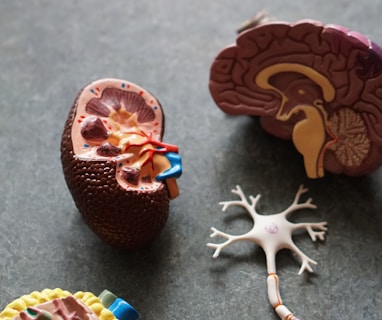Disrupted Synaptic Pruning
Discover how disrupted synaptic pruning can impact brain development and contribute to neurodevelopmental disorders. Learn about treatment and prevention strategies in this informative article.
BOOK STORE
Luke Howt
4/26/20232 min read


Disrupted Synaptic Pruning: How It Affects Brain Development
I. Introduction
The human brain is a complex organ that undergoes continuous changes throughout life. One of the most critical processes that occurs during brain development is synaptic pruning. In this section, we will explain what synaptic pruning is and its essential role in brain development.
II. Disrupted Synaptic Pruning
A. Definition and causes of disrupted synaptic pruning
Synaptic pruning is the process of eliminating unnecessary connections between neurons to optimize brain function. Disrupted synaptic pruning occurs when this process is not adequately regulated, leading to an imbalance of connections in the brain. This imbalance can result from genetic mutations, environmental factors, or a combination of both.
B. Effects on brain development
Disrupted synaptic pruning can have significant effects on brain development, including impairments in cognitive, social, and emotional function. This disruption can lead to a variety of neurodevelopmental disorders, such as autism spectrum disorder (ASD), schizophrenia, and intellectual disability.
C. Examples of neurodevelopmental disorders associated with disrupted synaptic pruning
Autism Spectrum Disorder (ASD)
ASD is a neurodevelopmental disorder characterized by impaired social interaction, communication, and restricted and repetitive behavior. Studies have shown that individuals with ASD have altered patterns of synaptic pruning, which may contribute to the development of the disorder.
Schizophrenia
Schizophrenia is a severe mental illness characterized by delusions, hallucinations, and disordered thinking. Disrupted synaptic pruning in adolescence has been linked to an increased risk of developing schizophrenia.
Intellectual Disability
Intellectual disability is a condition characterized by below-average intellectual function and adaptive skills. Disrupted synaptic pruning during early development has been associated with intellectual disability.
III. Treatment and Prevention
A. Strategies for treating disrupted synaptic pruning
There is currently no specific treatment for disrupted synaptic pruning. However, some therapies, such as behavioral and cognitive interventions, may help individuals with neurodevelopmental disorders associated with disrupted synaptic pruning.
B. Ways to prevent disrupted synaptic pruning
Preventing disrupted synaptic pruning is challenging, as the causes are multifactorial. However, here are some ways to promote healthy brain development and potentially reduce the risk of disrupted synaptic pruning:
Healthy prenatal care: Ensuring healthy prenatal care can help reduce the risk of disruptions in brain development.
Early intervention: Identifying and addressing developmental delays early can help prevent further disruptions in brain development.
Healthy lifestyle choices: A healthy lifestyle, including a nutritious diet, regular exercise, and adequate sleep, can support healthy brain development.
Reduced exposure to environmental toxins: Avoiding exposure to toxins such as lead and pesticides may reduce the risk of disruptions in brain development.
IV. Conclusion
Disrupted synaptic pruning can have significant effects on brain development and contribute to the development of neurodevelopmental disorders. While there is currently no specific treatment for disrupted synaptic pruning, therapies and interventions can help individuals with these disorders. Promoting healthy brain development through healthy lifestyle choices and reducing exposure to toxins may also help reduce the risk of disrupted synaptic pruning. Further research is needed to better understand the causes of disrupted synaptic pruning and develop effective prevention and treatment strategies.
